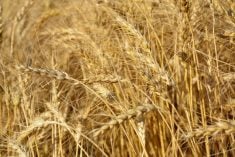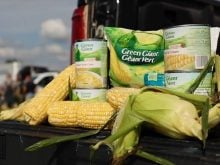The rains eased up a bit in the last week or so allowing some field activity, mainly on the sandier soils. Temperatures have remained on the cool side. Crop heat unit accumulation since May 1st is 175 which means that corn planted May 1 would just be emerging. Corn, soybean and tomato planting has begun.
Winter wheat
The winter wheat crop is approaching the flag leaf stage in the most advanced fields. Some winter wheat fields are still emerging which is extraordinary as it was planted 5 or 6 months earlier. Cold injury could impact the growth of this wheat. Nitrogen and sulphur applications are near completion. Sulphur deficiency is showing up on fields where sulphur was not applied. Those fields will need a sulphur application. In some areas a helicopter was used to apply the nitrogen to wet fields. It has been a challenge to apply herbicides and several fields are now past the window. Weed control should still be considered on thin wheat stands. If the flag leaf has emerged, the weed control window has closed. The window for application of Manipulator is still open and it can be tank mixed with a herbicide or fungicide if necessary. A grower applied a herbicide, fungicide and manganese together to a wheat field and saw significant speckling of the wheat.
Read Also

Women who fed a nation
More than 40,000 young women supported the war effort between the 1940s and early 1950s, helping grow and harvest crops amid labour shortages. They were called Farmerettes.
Poor fields are looking greener now and growers are considering keeping them. A few more fields are being kept than expected. Some are leaving them as a way to manage work load. It is hard to determine the yield potential of these fields and the uneven growth will make it challenging for a T3 fungicide application to protect against fusarium head blight. Watch the growth stage and target the application when most of the crop is at the correct stage. If the yield potential is not 80 bu/ac then it probably should be taken out. To date there has been very little disease in the wheat. Stripe rust in low levels in US and has progressed up to Kentucky. Since the meeting sharp-eyed Deb Campbell with Agronomy Advantage reported finding a single stripe rust lesion in a field, near Wingham. The weather is favourable for stripe rust so Deb will continue to monitor that field but it is important to keep checking your wheat as growers focus is on corn and soybean planting. If there is significant DON in the wheat grain the discount is $50/ ton for feed grade. So, a T3 fungicide will pay for itself on wheat yielding as low as 60 bu/ac.
Spring cereals are emerged and looking good.
Corn
Corn planting began on the lighter soils around the area and is off to a good start in areas west of Kitchener, Thorndale, Thamesford and down to Simcoe. Some growers are making plans to switch hybrids but for the most part there has been very little switching so far. Seed treatments could make it difficult for growers to switch corn hybrids if the current hybrid has a non neonic seed treatment and what they are switching to is treated with a neonic seed treatment. Corn planting ranges from about 5 per cent to 10 per cent west of London to 15 per cent towards Simcoe. Individual growers could have as much as 50 per cent of the crop planted. Commenting on Dave Hooker’s data showing corn having 95 per cent yield potential on June 1 in this area, Terry Daynard said the planting date only affects up to 5 per cent of yield potential. Corn that was planted in April is in a claim position with crop insurance.
Soybeans
Soybeans have been going in the ground as growers plant soybeans before corn or at the same time as they are planting corn. The reasoning of many of these growers is to ensure they can get wheat planted this fall and avoid a repeat of last fall.
Horticulture crops
Tomato planting began on May 15th and to date about 20 per cent of the crop is in the ground, mostly in the Leamington area. Normally about 60 per cent of the crop would be planted by now. Tomato plant quality is good. The growers have been able to hold the plants well. The cloudy days have helped with that. The sugarbeet crop is at the second true leaf stage so it is time for a herbicide application. That will be glyphosate unless fleabane is present requiring the addition of Lontrel. Michigan Sugar says about 80 per cent of their acreage is planted. Ontario and eastern parts of Michigan have had difficulty getting the crop in. Ontario is about 30 to 38 per cent planted.
There are a lot of horticulture crops in the area that can be affected by herbicide drift as well as plants on rural properties. Be aware of nearby crops, wind direction and speed, and what is in the tank when spraying!
Canola, hay and cover crops
The winter canola crop is flowering and is being scouted to time fungicide application at 30 per cent flowering, if needed. The hay crop is poor in many areas. Many growers are seeding new acres. A few are planting cereals or other alternatives to help replace the lost hay. Cover crop rye is approaching the flag leaf stage so it is becoming more difficult to control.













